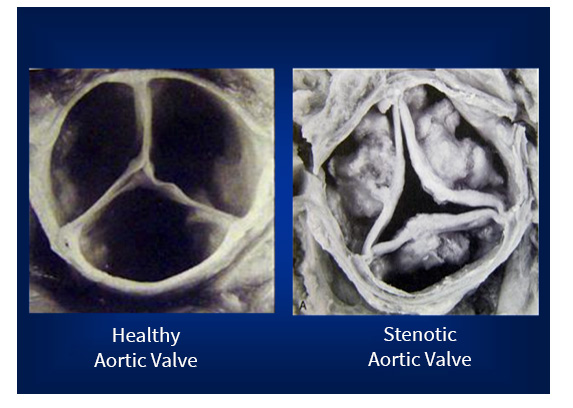CARDIOVASCULAR DISEASES
AORT VALVE STENOSIS
Aorta is the main vessel which carries the oxygenated blood to the whole body. The blood is oxygenated in lungs and then flow to the left ventricle. Left ventricle pumps the oxygenated blood to the whole body by aorta. There is a tricuspid semilunar valve in the aorta and this valve is opened by systole of the left ventricle and is closed by the diastole of the left ventricle.
If a stenosis is developed on the aortic valve, forward stroke volume from the left ventricle will decrease and afterload of the heart will increase. In the course of time, left ventricular myocardial mass will increase and due to the afterload mismatch between left ventricle and stenotic aortic valve, severe left ventricular failure, syncope attacks and sudden death can develop.
The common causes of aortic stenosis in young adults are: degeneration of a bicuspid aorta (A congenital defect of aortic valve), rheumatic heart disease and very rarely infective endocarditis. However, the most important cause of aortic stenosis in the elderly is calcific degenerative aortic valve disease which causes severe calcification and degeneration on the aortic valve.

If there is angina and aortic stenosis, 50% of these patients will die within 5 years. If there is syncope and aortic valve stenosis, 50% of these patients will die within 3 years. If a symptom of heart failure is developed, 50% of these patients will die within 2 years. Thus, symptomatic severe aortic valve stenosis is a mortal disease which requires emergency treatment.
The medical therapy in aortic valve stenosis only decreases the severity of symptoms and there is not any positive effect of medical therapy on survival. It is not possible to improve a degenerative calcific aortic valve by medical therapy.
In past, the only treatment of aortic valve stenosis was to implant a mechanical or bioprosthesis valve by open surgery. However, we can treat high risk patients who can not undergo to open surgery by a closed method termed as transcatheter aortic valve implantation (TAVI).
WHO ARE THE CANDIDATES FOR THE TAVI PROCEDURE?
TAVI procedure is not used for all patients with severe aortic valve stenosis. This closed method is only used for patients who are very high risk subjects considered unsuitable for surgery. If there is a chance of the patient for an open surgery and if the patient’s risk score is low, open surgery is preferably recommended.
However, this disease is the main native valve disease of older patients and there are several comorbid conditions in these old patients which directly effect both results of the open surgery and decrease survival.
Currently, there are some important risk scores which were developed according to the presence or absence of comorbid disease and conditions among patients with aortic valve stenosis. If the number of these risk factors are higher, the risk score will increase and mortality will increase by open surgery.
Thus, a patient with the diagnosis of aortic valve stenois must be evaluated by an heart team composed of an interventional cardiologist, a cardiologist, a cardiovascular anesthesiologist and a heart surgeon. If the patient’s risk score is high, and if there are important comorbid conditions, TAVI must be considered.
How do we apply percutaneous transcatheter aortic valve implantation?
